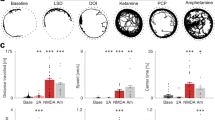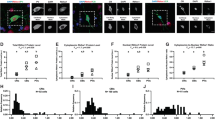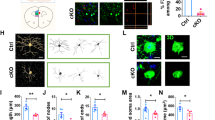Abstract
Neuronal firing is a fundamental element of cerebral function; and, voltage-gated potassium (K+) channels regulate that firing through the repolarization of action potentials. Kv3-type channels (Kv3.1–Kv3.4) represent a family of voltage-gated K+ channels that have fast-spiking properties. Kv3.1 channel subunits are predominantly localized to cortical parvalbumin (PV)-positive, inhibitory interneurons. The firing properties of these interneurons participate in establishing the normal gamma oscillations and synchrony of cortical neuronal populations, thought to be the signature of higher information processing in human brain. Schizophrenia (SZ) is associated with abnormalities in cortical gamma synchrony and in information processing, particularly with dysfunction in working memory and executive function. Here, we report the distribution of Kv3.1b and Kv3.2 protein in normal human brain, showing that Kv3.1b is limited to neocortical areas, whereas Kv3.2 is abundantly represented in neo- and subcortical regions. In SZ cases, levels of Kv3.1b protein are decreased in the neocortex, but only in cases without antipsychotic drug (APD) treatment; Kv3.1 levels are normal in antipsychotic-treated cases. Kv3.2 is not different in distribution or in level between normal and SZ cases, nor influenced by APD, in any region tested. The apparent increase in Kv3.1b protein levels by APDs in SZ neocortex was confirmed in laboratory rodents treated with chronic APDs. These findings show a decrease in Kv3.1b channel protein in SZ neocortex, a deficit that is restored by APDs. This alteration could be fundamentally involved in the cortical manifestations of SZ and in the therapeutic response to APDs.
This is a preview of subscription content, access via your institution
Access options
Subscribe to this journal
Receive 12 print issues and online access
$259.00 per year
only $21.58 per issue
Buy this article
- Purchase on Springer Link
- Instant access to full article PDF
Prices may be subject to local taxes which are calculated during checkout





Similar content being viewed by others
References
Sohal VS, Zhang F, Yizhar O, Deisseroth K . Parvalbumin neurons and gamma rhythms enhance cortical circuit performance. Nature 2009; 459: 698–702.
Cardin JA, Carlen M, Meletis K, Knoblich U, Zhang F, Deisseroth K et al. Driving fast-spiking cells induces gamma rhythm and controls sensory responses. Nature 2009; 459: 663–667.
Fries P, Nikolic D, Singer W . The gamma cycle. Trends Neurosci 2007; 30: 309–316.
Uhlhaas PJ, Singer W . Abnormal neural oscillations and synchrony in schizophrenia. Nat Rev Neurosci 2010; 11: 100–113.
Kwon JS, O’Donnell BF, Wallenstein GV, Greene RW, Hirayasu Y, Nestor PG et al. Gamma frequency-range abnormalities to auditory stimulation in schizophrenia. Arch Gen Psychiatry 1999; 56: 1001–1005.
Spencer KM, Salisbury DF, Shenton ME, McCarley RW . Gamma-band auditory steady-state responses are impaired in first episode psychosis. Biol Psychiatry 2008; 64: 369–375.
Roach BJ, Mathalon DH . Event-related EEG time-frequency analysis: an overview of measures and an analysis of early gamma band phase locking in schizophrenia. Schizophr Bull 2008; 34: 907–926.
Spencer KM, Niznikiewicz MA, Shenton ME, McCarley RW . Sensory-evoked gamma oscillations in chronic schizophrenia. Biol Psychiatry 2008; 63: 744–747.
Haenschel C, Bittner RA, Waltz J, Haertling F, Wibral M, Singer W et al. Cortical oscillatory activity is critical for working memory as revealed by deficits in early-onset schizophrenia. J Neurosci 2009; 29: 9481–9489.
Cho RY, Konecky RO, Carter CS . Impairments in frontal cortical gamma synchrony and cognitive control in schizophrenia. Proc Natl Acad Sci USA 2006; 103: 19878–19883.
Boutros NN, Arfken C, Galderisi S, Warrick J, Pratt G, Iacono W . The status of spectral EEG abnormality as a diagnostic test for schizophrenia. Schizophr Res 2008; 99: 225–237.
Rutter L, Carver FW, Holroyd T, Nadar SR, Mitchell-Francis J, Apud J et al. Magnetoencephalographic gamma power reduction in patients with schizophrenia during resting condition. Hum Brain Mapp 2009; 30: 3254–3264.
Lewis DA, Hashimoto T, Volk DW . Cortical inhibitory neurons and schizophrenia. Nat Rev Neurosci 2005; 6: 312–324.
Akbarian S, Huang HS . Molecular and cellular mechanisms of altered GAD1/GAD67 expression in schizophrenia and related disorders. Brain Res Rev 2006; 52: 293–304.
Volk DW, Austin MC, Pierri JN, Sampson AR, Lewis DA . Decreased glutamic acid decarboxylase67 messenger RNA expression in a subset of prefrontal cortical gamma-aminobutyric acid neurons in subjects with schizophrenia. Arch Gen Psychiatry 2000; 57: 237–245.
Curley AA, Arion D, Volk DW, Asafu-Adjei JK, Sampson AR, Fish KN et al. Cortical deficits of glutamic acid decarboxylase 67 expression in schizophrenia: clinical, protein, and cell type-specific features. Am J Psychiatry 2011; 168: 921–929.
Rudy B, McBain CJ . Kv3 channels: voltage-gated K+ channels designed for high-frequency repetitive firing. Trends Neurosci 2001; 24: 517–526.
Coetzee WA, Amarillo Y, Chiu J, Chow A, Lau D, McCormack T et al. Molecular diversity of K+ channels. Ann NY Acad Sci 1999; 868: 233–285.
Porcello DM, Ho CS, Joho RH, Huguenard JR . Resilient RTN fast spiking in Kv3.1 null mice suggests redundancy in the action potential repolarization mechanism. J Neurophysiol 2002; 87: 1303–1310.
Lau D, Vega-Saenz de Miera EC, Contreras D, Ozaita A, Harvey M, Chow A et al. Impaired fast-spiking, suppressed cortical inhibition, and increased susceptibility to seizures in mice lacking Kv3.2 K+ channel proteins. J Neurosci 2000; 20: 9071–9085.
Joho RH, Ho CS, Marks GA . Increased gamma- and decreased delta-oscillations in a mouse deficient for a potassium channel expressed in fast-spiking interneurons. J Neurophysiol 1999; 82: 1855–1864.
Atzori M, Lau D, Tansey EP, Chow A, Ozaita A, Rudy B et al. H2 histamine receptor-phosphorylation of Kv3.2 modulates interneuron fast spiking. Nat Neurosci 2000; 3: 791–798.
Espinosa F, Marks G, Heintz N, Joho RH . Increased motor drive and sleep loss in mice lacking Kv3-type potassium channels. Genes Brain Behav 2004; 3: 90–100.
Grabert J, Wahle P . Neuronal activity and TrkB ligands influence Kv3.1b and Kv3.2 expression in developing cortical interneurons. Neuroscience 2008; 156: 618–629.
Stan AD, Ghose S, Gao XM, Roberts RC, Lewis-Amezcua K, Hatanpaa KJ et al. Human postmortem tissue: What quality markers matter? Brain Res 2006; 1123: 1–11.
Ozaita A, Martone ME, Ellisman MH, Rudy B . Differential subcellular localization of the two alternatively spliced isoforms of the Kv3.1 potassium channel subunit in brain. J Neurophysiol 2002; 88: 394–408.
Tansey EP, Chow A, Rudy B, McBain CJ . Developmental expression of potassium-channel subunit Kv3.2 within subpopulations of mouse hippocampal inhibitory interneurons. Hippocampus 2002; 12: 137–148.
Akbarian S, Kim JJ, Potkin SG, Hagman JO, Tafazzoli A, Bunney WE Jr et al. Gene expression for glutamic acid decarboxylase is reduced without loss of neurons in prefrontal cortex of schizophrenics. Arch Gen Psychiatry 1995; 52: 258–266.
Hashimoto T, Arion D, Unger T, Maldonado-Aviles JG, Morris HM, Volk DW et al. Alterations in GABA-related transcriptome in the dorsolateral prefrontal cortex of subjects with schizophrenia. Mol Psychiatry 2008; 13: 147–161.
Hashimoto T, Volk DW, Eggan SM, Mirnics K, Pierri JN, Sun Z et al. Gene expression deficits in a subclass of GABA neurons in the prefrontal cortex of subjects with schizophrenia. J Neurosci 2003; 23: 6315–6326.
Fung SJ, Webster MJ, Sivagnanasundaram S, Duncan C, Elashoff M, Weickert CS . Expression of interneuron markers in the dorsolateral prefrontal cortex of the developing human and in schizophrenia. Am J Psychiatry 2010; 167: 1479–1488.
Mellios N, Huang HS, Baker SP, Galdzicka M, Ginns E, Akbarian S . Molecular determinants of dysregulated GABAergic gene expression in the prefrontal cortex of subjects with schizophrenia. Biol Psychiatry 2009; 65: 1006–1014.
Hashimoto T, Bazmi HH, Mirnics K, Wu Q, Sampson AR, Lewis DA . Conserved regional patterns of GABA-related transcript expression in the neocortex of subjects with schizophrenia. Am J Psychiatry 2008; 165: 479–489.
Lodge DJ, Behrens MM, Grace AA . A loss of parvalbumin-containing interneurons is associated with diminished oscillatory activity in an animal model of schizophrenia. J Neurosci 2009; 29: 2344–2354.
Meyer U, Nyffeler M, Yee BK, Knuesel I, Feldon J . Adult brain and behavioral pathological markers of prenatal immune challenge during early/middle and late fetal development in mice. Brain Behav Immun 2008; 22: 469–486.
Hikida T, Jaaro-Peled H, Seshadri S, Oishi K, Hookway C, Kong S et al. Dominant-negative DISC1 transgenic mice display schizophrenia-associated phenotypes detected by measures translatable to humans. Proc Natl Acad Sci USA 2007; 104: 14501–14506.
Shen S, Lang B, Nakamoto C, Zhang F, Pu J, Kuan SL et al. Schizophrenia-related neural and behavioral phenotypes in transgenic mice expressing truncated Disc1. J Neurosci 2008; 28: 10893–10904.
Pratt JA, Winchester C, Egerton A, Cochran SM, Morris BJ . Modelling prefrontal cortex deficits in schizophrenia: implications for treatment. Br J Pharmacol 2008; 153 (Suppl 1): S465–S470.
Chow A, Erisir A, Farb C, Nadal MS, Ozaita A, Lau D et al. K(+) channel expression distinguishes subpopulations of parvalbumin- and somatostatin-containing neocortical interneurons. J Neurosci 1999; 19: 9332–9345.
Lee KH, Williams LM, Breakspear M, Gordon E . Synchronous gamma activity: a review and contribution to an integrative neuroscience model of schizophrenia. Brain Res Brain Res Rev 2003; 41: 57–78.
Sun Y, Farzan F, Barr MS, Kirihara K, Fitzgerald PB, Light GA et al. Gamma oscillations in schizophrenia: mechanisms and clinical significance. Brain Res 2011; 1413: 98–114.
Amann LC, Gandal MJ, Halene TB, Ehrlichman RS, White SL, McCarren HS et al. Mouse behavioral endophenotypes for schizophrenia. Brain Res Bull 2010; 83: 147–161.
Baldeweg T, Spence S, Hirsch SR, Gruzelier J . Gamma-band electroencephalographic oscillations in a patient with somatic hallucinations. Lancet 1998; 352: 620–621.
Lee KH, Williams LM, Haig A, Gordon E . ‘Gamma (40 Hz) phase synchronicity’ and symptom dimensions in schizophrenia. Cogn Neuropsychiatry 2003; 8: 57–71.
Gandal MJ, Edgar JC, Klook K, Siegel SJ . Gamma synchrony: towards a translational biomarker for the treatment-resistant symptoms of schizophrenia. Neuropharmacology 2012; 62: 1504–1518.
Jones NC, Reddy M, Anderson P, Salzberg MR, O'Brien TJ, Pinault D . Acute administration of typical and atypical antipsychotics reduces EEG gamma power, but only the preclinical compound LY379268 reduces the ketamine-induced rise in gamma power. Int J Neuropsychopharmacol 2012; 15: 657–668.
Huffaker SJ, Chen J, Nicodemus KK, Sambataro F, Yang F, Mattay V et al. A primate-specific, brain isoform of KCNH2 affects cortical physiology, cognition, neuronal repolarization and risk of schizophrenia. Nat Med 2009; 15: 509–518.
Shepard PD, Canavier CC, Levitan ES . Ether-a-go-go-related gene potassium channels: what’s all the buzz about? Schizophr Bull 2007; 33: 1263–1269.
Wellcome Trust Case Control Consortium. Genome-wide association study of 14,000 cases of seven common diseases and 3,000 shared controls. Nature 2007; 447: 661–678.
Acknowledgements
These studies were supported by NIMH (MH 062236 and MH 83957).
Author information
Authors and Affiliations
Corresponding author
Ethics declarations
Competing interests
The authors declare no conflict of interest.
Additional information
3RH Joho is recently deceased.
Supplementary Information accompanies the paper on the Molecular Psychiatry website
Rights and permissions
About this article
Cite this article
Yanagi, M., Joho, R., Southcott, S. et al. Kv3.1-containing K+ channels are reduced in untreated schizophrenia and normalized with antipsychotic drugs. Mol Psychiatry 19, 573–579 (2014). https://doi.org/10.1038/mp.2013.49
Received:
Revised:
Accepted:
Published:
Issue Date:
DOI: https://doi.org/10.1038/mp.2013.49
Keywords
This article is cited by
-
A cytoskeleton-membrane interaction conserved in fast-spiking neurons controls movement, emotion, and memory
Molecular Psychiatry (2023)
-
Biological subtyping of psychiatric syndromes as a pathway for advances in drug discovery and personalized medicine
Nature Mental Health (2023)
-
A general pattern of non-spiking neuron dynamics under the effect of potassium and calcium channel modifications
Journal of Computational Neuroscience (2023)
-
Application of evoked response audiometry for specifying aberrant gamma oscillations in schizophrenia
Scientific Reports (2022)
-
The effects of AUT00206, a novel Kv3.1/3.2 potassium channel modulator, on task-based reward system activation: a test of mechanism in schizophrenia
Psychopharmacology (2022)



